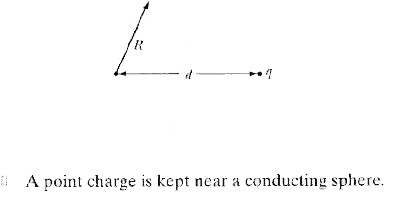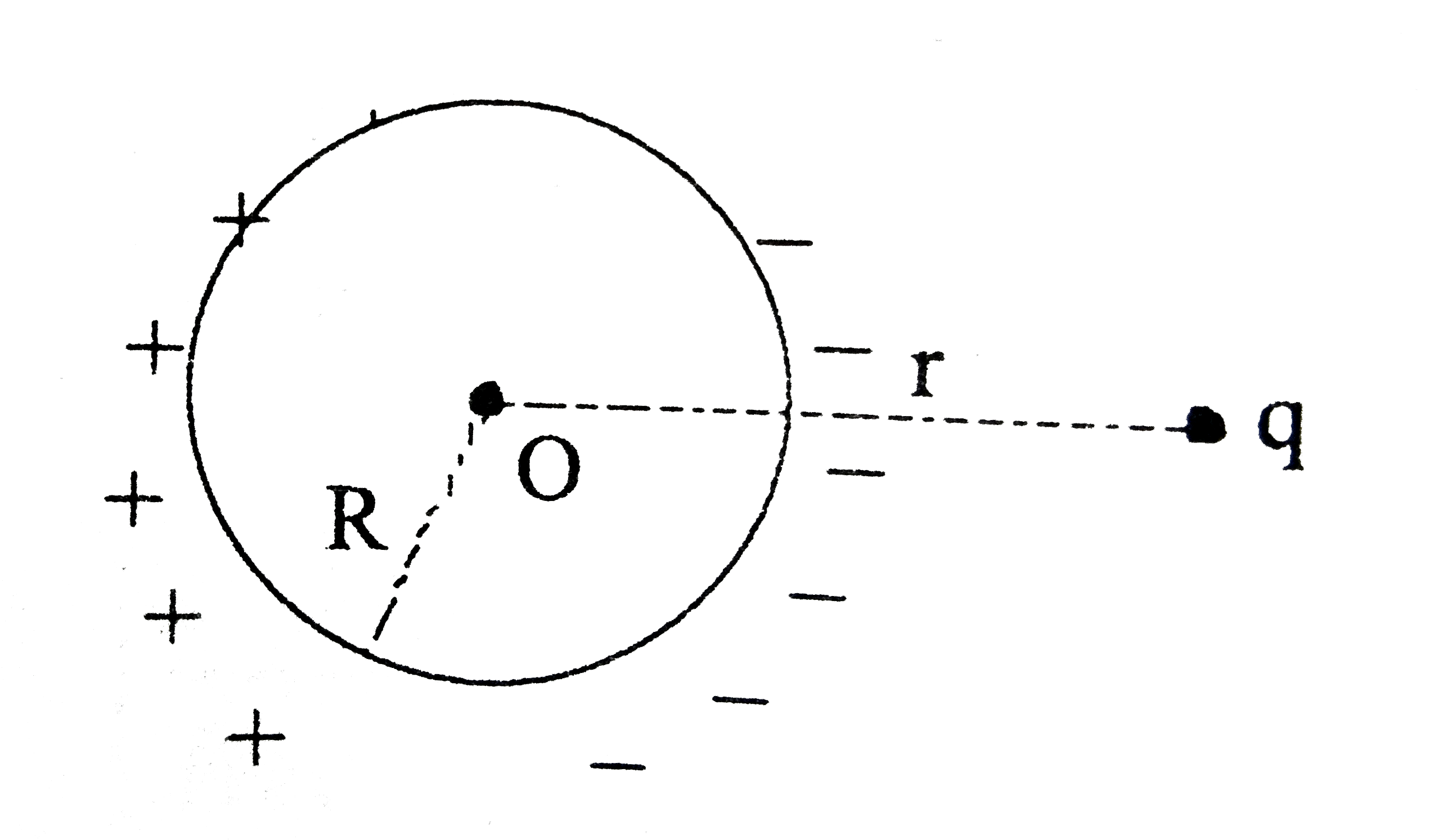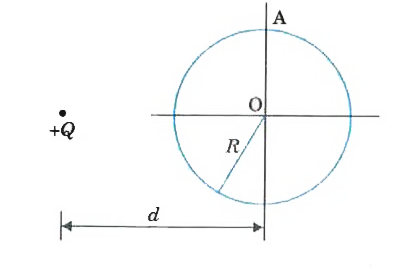In the above problem, find the electric field and electric potential at the centre of the sphere due to induced charges on the sphere?
14π∈0QR2and0
0and14π∈0QR
14π∈0QR2and14π∈0QR
0 and 0
The correct Answer is:D
To find the electric field and electric potential at the center of a sphere due to induced charges on the sphere, we can follow these steps:
1. Understanding the Setup:
- We have a conducting sphere with a charge Q placed at a distance R from its center. The presence of this external charge will induce charges on the surface of the conductor.
2. Induced Charges:
- The external charge Q will induce negative charges on the side of the sphere closest to the charge and positive charges on the side farthest from it. This distribution of charges will be such that the total induced charge on the sphere remains zero since the sphere is a conductor.
3. Electric Field Inside the Conductor:
- According to electrostatic principles, the electric field inside a conductor in electrostatic equilibrium is always zero. Therefore, the electric field at the center of the sphere due to the induced charges is:
E=0N/C
4. Electric Potential Inside the Conductor:
- The electric potential inside a conductor is constant and equal to the potential on its surface. Since the net charge on the conductor is zero (as the induced charges balance each other), the potential at the center of the sphere due to the induced charges is also zero:
V=0V
5. Final Answers:
- Therefore, the electric field at the center of the sphere due to the induced charges is 0N/C and the electric potential at the center is 0V.
Summary:
- Electric Field E=0N/C
- Electric Potential V=0V
- We have a conducting sphere with a charge Q placed at a distance R from its center. The presence of this external charge will induce charges on the surface of the conductor.
- The external charge Q will induce negative charges on the side of the sphere closest to the charge and positive charges on the side farthest from it. This distribution of charges will be such that the total induced charge on the sphere remains zero since the sphere is a conductor.
- According to electrostatic principles, the electric field inside a conductor in electrostatic equilibrium is always zero. Therefore, the electric field at the center of the sphere due to the induced charges is:
E=0N/C
- The electric potential inside a conductor is constant and equal to the potential on its surface. Since the net charge on the conductor is zero (as the induced charges balance each other), the potential at the center of the sphere due to the induced charges is also zero:
V=0V
- Therefore, the electric field at the center of the sphere due to the induced charges is 0N/C and the electric potential at the center is 0V.
- Electric Field E=0N/C
- Electric Potential V=0V
Topper's Solved these Questions
- BOOK - NARAYNACHAPTER - ELECTROSTATIC POTENTIAL AND CAPACITANCEEXERCISE - Evaluate yourself-75videos
ELECTROSTATIC POTENTIAL AND CAPACITANCE
- BOOK - NARAYNACHAPTER - ELECTROSTATIC POTENTIAL AND CAPACITANCEEXERCISE - Evaluate yourself-83videos
ELECTROSTATIC POTENTIAL AND CAPACITANCE
- BOOK - NARAYNACHAPTER - ELECTROSTATIC POTENTIAL AND CAPACITANCEEXERCISE - Evaluate yourself-56videos
ELECTROSTATIC POTENTIAL AND CAPACITANCE
- BOOK - NARAYNACHAPTER - ELECTROMAGNETIC WAVES EXERCISE - EXERCISE -415videos
ELECTROMAGNETIC WAVES
- BOOK - NARAYNACHAPTER - ELECTROSTATICS AND GAUSS LAWEXERCISE - Intergers type question11videos
ELECTROSTATICS AND GAUSS LAW
Similar Questions
Find the electric field at the center of the sphere due to the induced charges on the surface of the sphere, as shown in Fig. 22-30.
 View Solution
View SolutionA charge q kept in front of a neutal metallic sphere. Find the electric field at the centre of sphere due to the induced charges on the surface of the sphere shown.
The net electric field inside the conductor is zero. This is produced by induced charged and the external charge.
 View Solution
View Solution
Knowledge Check
- Question 1 - Select One
An insulating solid sphere of radius R has a uniformaly positive charge density ρ. As a result of this uniform charge distribution there is a finite value of electric potential at the centre of the sphere, at the surface of the sphere and also at a point out side the sphere. The electric potential at infinity is zero.
Statement-1: Wgen a charge 'q' is taken from the centre to the surface of the sphere, its potential energy charges by qρ3∈0
Statement-2 : The electric field at a distance r(r<R) from the centre of the the sphere is ρr3∈0AStatement-1 is true, Statement-2 is true and Statement-2 is the correct explanation of Statement-1BStatement-1 is true, Statement-2 is true and Statement-2 is not the correct explanation of Statement-1CStatement-1 is true, Statement-2 is falseDStatement-1 is false, Statement-2 is true - Question 2 - Select One
An insulating solid sphere of radius R has a uniformly positive charge density ρ. As a result of this uniform charge distribution there is a finite value of electric potential at the centre of the sphere, at the surface of the sphere and also at a point out side the sphere. The electric potential at infinity is zero.
Statement-1: When a charge 'q' is taken from the centre to the surface of the sphere, its potential energy changes by qρ3∈0
Statement-2 : The electric field at a distance r(r<R) from the centre of the the sphere is ρr3∈0A(a) Statement 1 is true, Statement 2 is true, Statement 2 is not the correct explanation of statement 1.B(b) Statement 1 is true Statement 2 is false.C(c) Statement 1 is false Statement 2 is true.D(d) Statement 1 is true, Statement 2 is true, Statement 2 is the correct explanation of Statement 1 - Question 3 - Select One
STATEMENT -1 : Consider a conducting sphere of radius R. Now a charge q is placed in front of shphere . Electric potential at point O is Kqr

STATEMENT -2: Electric potential at the centre of sphere due to induced charges is zero.AStatement -1 is True , Statement -2 is True ,
Statement -2 is a correct explanation for
Statement -10BStatement -1 is Tre , Statement -2 is True ,
Statement -2 is NOT a correct explanation for statement -1.CStatement -1 true, Statement -2 is False.DStatement -1 is False , Statement -2 is true.
Electric field due to spheres
View SolutionConsider a metallic hollow sphere with its centre at point O. Point charge +Q is kept in the vicinity of the given sphere as shown in the figure. If the sphere is electrically neutral, then calculate the electric potential at point A due to induced charges on the sphere only.
 View Solution
View SolutionElectric Field Due To Spheres|Electric Potential Due To Spheres|Questions
View SolutionAn electric dipole is placed at the centre of a sphere. Find the electric flux passing through the sphere.
View SolutionThe electric field between the two spheres of a charged spheres condenser
View Solution
